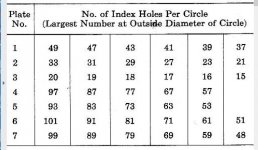I picked up a Walter dividing head.
It's model HU 100.
You can see a video of someone restoring one here:
YouTube
I only have two of the three plates.
63,57,49,37,36,29,24,22
59,51,43,39,31,28,24,23
Kind of odd that they made the hole patterns this way, but I'm sure there's some logical reason. Interesting that 24 is on two of the plates.
I can make the third plate, but I have no idea what the holes should be.
On the video, I was able to see the third one had 61,53 and 47, but couldn't see any more than that.
I couldn't find information on any other dividing heads that had hole counts that matched these so that I could fill in the missing numbers.
Does anyone have one of these and can you tell me the hole counts?
If not, what divisions are missing?
I'm missing the prime number 41, so that's a likely candidate.
Other numbers I am missing in the sequence from 22 to 63 include:
25,26,27,30,32,33,34,35,38,40,41,42,44,45,46,47,48,50,52,53,54,55,56,58,60,61,62
I understand that some of these would not be needed, but don't know which ones.
Steve
It's model HU 100.
You can see a video of someone restoring one here:
YouTube
I only have two of the three plates.
63,57,49,37,36,29,24,22
59,51,43,39,31,28,24,23
Kind of odd that they made the hole patterns this way, but I'm sure there's some logical reason. Interesting that 24 is on two of the plates.
I can make the third plate, but I have no idea what the holes should be.
On the video, I was able to see the third one had 61,53 and 47, but couldn't see any more than that.
I couldn't find information on any other dividing heads that had hole counts that matched these so that I could fill in the missing numbers.
Does anyone have one of these and can you tell me the hole counts?
If not, what divisions are missing?
I'm missing the prime number 41, so that's a likely candidate.
Other numbers I am missing in the sequence from 22 to 63 include:
25,26,27,30,32,33,34,35,38,40,41,42,44,45,46,47,48,50,52,53,54,55,56,58,60,61,62
I understand that some of these would not be needed, but don't know which ones.
Steve


